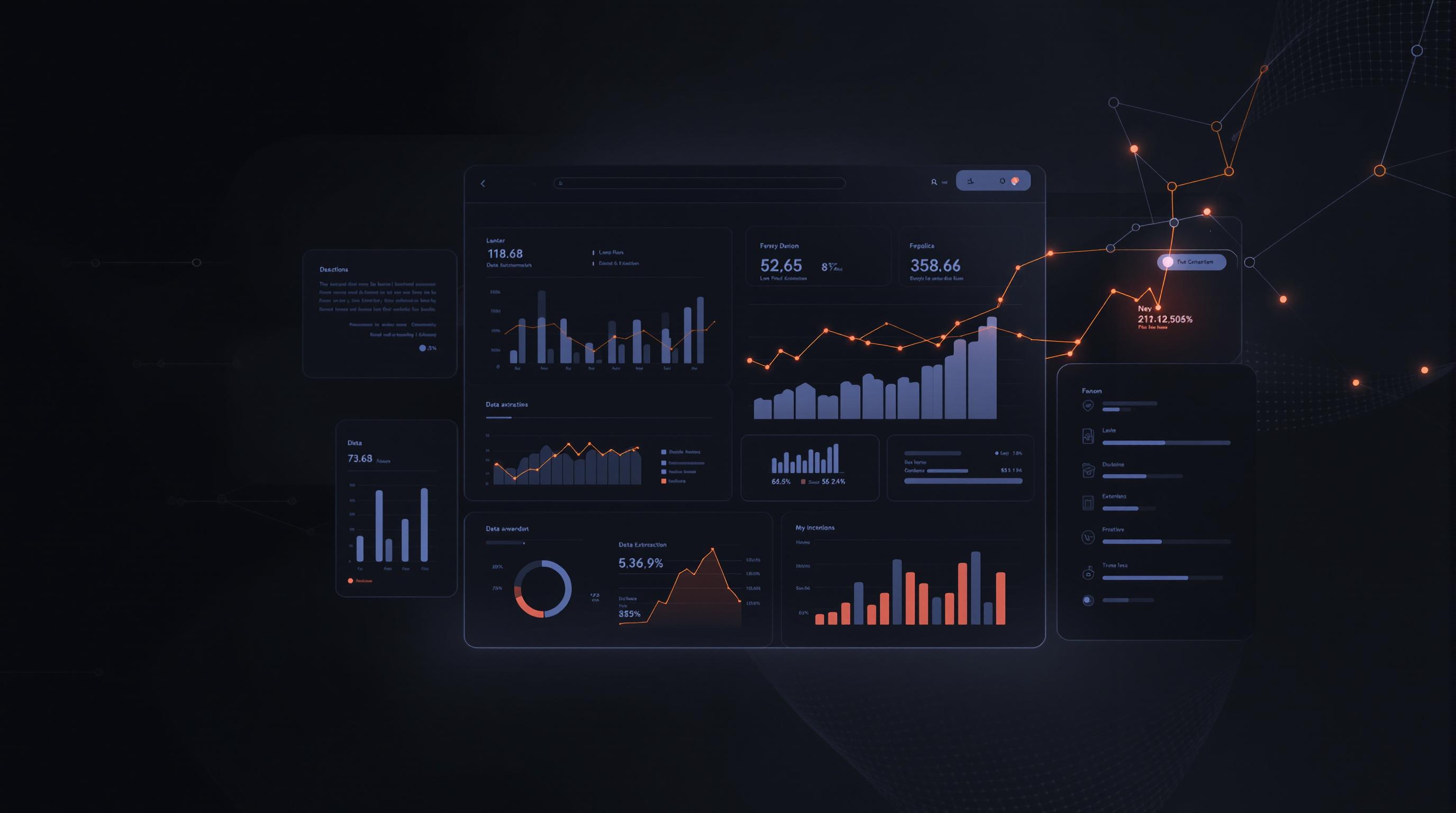Managing proxies for web scraping just got smarter. AI-driven proxy systems reduce IP bans by 50%, increase success rates by 35%, and cut proxy costs by up to 30%. Unlike traditional methods, AI adapts in real-time, automating proxy selection and rotation to handle anti-bot defenses effectively.
Key Benefits of AI Proxy Management:
- Fewer IP Bans: Up to 91% reduction in bans.
- Higher Success Rates: Achieve 95-99% success rates compared to 60-80% with manual methods.
- Cost Savings: Save 25-30% on proxy expenses.
- Real-Time Adjustments: AI adapts instantly to changing conditions.
- Scalability: Easily manage large proxy pools.
How It Works:
- Smart Techniques: AI uses reinforcement learning, neural networks, and clustering to optimize proxy performance.
- Self-Healing Systems: Automatically replaces failing proxies.
- NLP Integration: Routes requests based on content complexity.
Whether you're collecting e-commerce data or monitoring trends, AI-driven proxy management ensures faster, more reliable, and cost-effective web scraping. Ready to leave manual proxy rotation behind? Let AI handle it for you.
Industrial-scale Web Scraping with AI & Proxy Networks
How AI Improves Proxy Management
Key Components of AI Proxy Systems
AI-powered proxy systems rely on three main elements:
- Diverse IP pools: Including residential, datacenter, and mobile IPs.
- Real-time performance monitoring: Tracking metrics like speed, success rates, and response times.
- Self-healing mechanisms: Automatically replacing failing proxies to maintain efficiency.
Using real-time monitoring data, these systems make smarter routing decisions. They factor in historical performance, target site characteristics, and current request patterns. These components form the backbone of the AI strategies discussed below.
AI Techniques for Proxy Rotation
AI optimizes proxy rotation through several advanced methods:
- Reinforcement learning: Adapting through trial and error to improve over time.
- Neural networks: Identifying and responding to anti-bot patterns.
- Clustering: Grouping proxies based on performance metrics.
- NLP (Natural Language Processing): Analyzing response content to refine strategies.
"Oxylabs' AI-powered proxy rotation system reduced CAPTCHA encounters by 73% and IP bans by 91% compared to traditional rotation methods in a large-scale e-commerce scraping project", according to their 2024 performance study.
AI vs. Manual Proxy Management
Manual proxy management often achieves success rates between 60-80%. In contrast, AI-driven systems consistently deliver 95-99% success rates. This leap is due to AI's ability to analyze vast amounts of data and make instant, precise decisions - something manual methods can't match.
For example, Zyte's Smart Proxy Manager has shown a 25% increase in success rates compared to static methods, reinforcing the 35% performance boost often associated with AI adoption.
Setting Up AI-Driven Proxy Rotation
Steps for Configuring AI Proxy Management
To set up an AI-based proxy rotation system, you'll need to follow three main phases:
- Align your proxy pool: Ensure your proxy pool matches the IP diversity requirements. A commonly recommended mix is 70% residential proxies and 30% datacenter proxies. This balance offers strong performance while keeping costs reasonable. Make sure the geo-distribution aligns with your target site locations.
- Set performance benchmarks: Define clear metrics like a success rate of at least 95% and latency under 2 seconds. These benchmarks guide the AI system in optimizing its operations. Turn on the AI's self-learning feature so it can adjust rotation frequencies based on how target websites behave.
Integrating AI with Existing Tools
Connecting AI-powered proxy rotation to your current web scraping tools depends on your tech stack. Here's how integration might look in Python and Scrapy:
# Python integration example
from ai_proxy_manager import AIProxyManager
response = requests.get('https://example.com', proxies=ai_proxy.get_proxy())
# Scrapy middleware example
class AIProxyMiddleware:
def process_request(self, request, spider):
request.meta['proxy'] = ai_proxy.get_proxy()
These examples show how to create real-time feedback loops, helping the AI system continuously improve using neural networks and clustering techniques.
Best Practices for AI Proxy Rotation
Follow these strategies to get the most out of your AI proxy rotation system:
| Parameter | Setting | Why It Matters |
|---|---|---|
| Base Rotation Frequency | Every 10 requests | Balances stability with detection avoidance |
| Concurrent Requests | Start with 10 | Lets the AI scale based on actual performance |
| Retry Attempts | 3 with exponential backoff | Avoids aggressive retries while staying efficient |
| Performance Monitoring | Real-time metrics | Ensures quick responses to any issues |
Enable detailed logging to track proxy performance. Use circuit breakers to prevent system overload - these can pause operations if failure rates exceed 20%, giving the AI time to recalibrate its strategy.
Keep your proxy pool updated and let the AI learn continuously from both successful and failed requests. This ongoing learning process ensures the system adapts to changes in website behavior and anti-bot defenses effectively.
sbb-itb-f2fbbd7
Advanced AI Strategies for Proxy Optimization
Using Machine Learning to Assess Proxy Performance
Machine learning takes proxy evaluation to the next level by analyzing historical data like success rates, response times, and ban frequencies. These models can predict problematic proxies with up to 85% accuracy, helping prevent failures before they happen.
Some key metrics driving these evaluations:
| Metric | What It Measures | Impact on Performance |
|---|---|---|
| Success Rate | Valid data return percentage | Indicates how reliable a proxy is |
| Response Time | Speed of request completion | Directly affects scraping speed |
| Ban Frequency | How often proxies get blocked | Impacts how long proxies remain usable |
Using these metrics, the system automatically drops underperforming proxies and replaces them with better options. This ensures continuous improvement and keeps performance levels high.
Using NLP for Request Routing
Natural Language Processing (NLP) adds a layer of intelligence to proxy routing by analyzing web content and structure in real time. This allows the system to assign proxies based on the type and complexity of the content.
For example, NLP can detect elements like product names or prices on e-commerce sites. When a request targets such data, it directs the traffic through proxies that have historically performed well for similar tasks. This makes the process more efficient and precise.
Using Reinforcement Learning for Dynamic Systems
Reinforcement learning enables proxy systems to adapt to changing conditions, much like a smart traffic controller. By using Q-learning algorithms, these systems learn from performance data in real time to make better decisions.
"Reinforcement learning in proxy systems is like having a self-improving, intelligent traffic controller for your web requests. It learns from every success and failure, continuously optimizing your proxy usage." - Mark Johnson, CTO of AI Proxy Solutions
When websites implement tougher security measures, the system can automatically adjust by reducing request frequency or switching to residential IPs with proven success for those domains. This dynamic approach ensures the system stays effective, even under challenging conditions.
Addressing Common Challenges in AI Proxy Management
Dealing with IP Bans and CAPTCHAs
Modern AI systems use real-time analysis to handle IP bans effectively. For example, Bright Data's AI solution reduces ban rates by 55% compared to older rotation methods. It achieves this by analyzing response patterns and status codes to predict and avoid bans more accurately.
Ensuring Proxy Pool Diversity
Zyte's system, with its 100 million IPs, ensures a wide range of proxy options by balancing several factors automatically:
- Geographic spread across different regions
- A mix of residential, datacenter, and mobile IPs
- ASN variety to minimize detection risks
- Performance measures like latency and uptime
The system continuously monitors and adjusts these metrics to meet changing website requirements while maintaining a diverse proxy pool.
Maintaining Data Quality During Rotations
By leveraging advanced session management techniques, AI systems ensure that data quality remains consistent, even during proxy rotations. These systems achieve 95% data consistency by using validation models to flag anomalies.
"The key to maintaining data quality isn't just about rotating proxies - it's about understanding the relationship between proxy performance and data integrity. Our AI systems can maintain consistent browser fingerprints across rotations while adapting to website behavior in real-time", says a senior engineer at ScrapingRobot.
These validation models, also discussed in the 'Machine Learning to Assess Proxy Performance' section, play a crucial role in ensuring reliable data collection during frequent rotations.
Conclusion and Key Points
Benefits of AI-Driven Proxy Management
AI-driven proxy management is changing the game for organizations managing large-scale data collection. According to Bright Data, companies have seen a 35% boost in successful requests, all while cutting proxy usage by 20% compared to older methods.
The advantages don’t stop at efficiency. Zyte reports that its clients achieved an average 30% drop in proxy-related expenses after switching to AI-driven systems. This aligns with earlier case studies showing similar 25-30% cost reductions.
"AI-driven proxy management is not just an optimization; it's a paradigm shift in how we approach large-scale data collection." - Dr. Elena Rodriguez, Chief Data Scientist at Scrapinghub, Web Scraping Today Magazine
Steps Toward AI Tool Adoption
Organizations can unlock these benefits by gradually integrating AI tools into their processes. For example, Datasembly introduced AI proxy management and saw impressive results: their scraping failure rate dropped from 18% to just 3.2% within three months, even while handling 1.2 billion daily requests.


